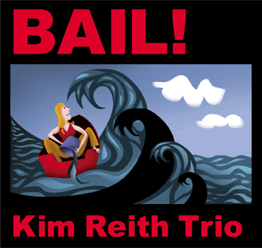 BAIL! now available
BAIL! now available| K i m R e i t h home compositions Bail! (CD) compositional notes on "Bail!" order reviews bio links contact résumé edmund j wood |
 BAIL! now available
BAIL! now availableScroll down for liner notes and audio samples...
In October 1999 the Kim Reith Trio, consisting of Kim Reith on electric hollow body guitar, Bruce Grafrath on acoustic bass, and Kevin Green, drums, recorded an album of nine originals by bandleader Reith, plus one Thelonious Monk tune. The band stretches out over swinging pieces that feature unusual harmonic progressions, changes in meter and dynamic melodies.
"I like to use my compositions as a way to pose musical problems for the improviser to deal with. This sparks the players' creativity and makes the performance more edgy and electric," says Reith.
The jazz-guitar trio is more open and spare sounding than a comparable piano trio, partly because the chordal voicings on guitar use fewer notes than most piano voicings. In the bass this feature is even more outstanding, giving improvisers great freedom over the form.
BAIL! cover art and artist Barbara Meyer Fiore; click for more info
Click the highlighted tracks below to hear streaming RealPlayer audio samples from the album. Download free RealPlayer
|
|
|
All compositions by Kimi Reith Recorded:
|
Buythealbum! |
Album liner notes...The
compositions
on BAIL! were
written between 1995 and 2000. I usually write the melody of
a piece first, the (chord) changes last. After writing a melody
1 Gargantua: 6:01 The 22-bar head features odd progressions, intervalic leaps, and rhythmic displacement: the first motif recurs 4 times, each starting on a different beat. I wasn't thinking in terms of specific scales. For improvisational ease the solo form was later simplified to 24 bars and more conventional changes. 2 Bail: 4:58 A 12-bar piece in two meters, 4/4 going to 5/4 and back. Bail is written around several scales: Lydian dominant and altered modes of the melodic minor, the symmetrical dominant (1/2 W 1/2 W 1/2 W 1/2 W intervals), and the whole tone scale. 3 Proximity: 8:01 An earlier piece, I was playing around with adjacent arpeggios which create similar geometric patterns on the fretboard of a guitar. Visual patterns have always fascinated me and sometimes are the origin of motifs in my playing. Except for the bridge, it's written around the harmonic minor scale. 4 Kindergarten: 6:44 I wanted to recapture the sense of wonder young kids feel toward life. The piece is based on a blues form, but in bars 5 - 6, instead of going to the IV7, it goes to a harmonic minor tonal center, evoking a sense of mystery and reverence. 5 Lazybones: 7:08 A polytonal piece built around the Eb whole tone scale and the Ab blues scale. |
6 Lunacy: 5:30 The simplest explanation
for this piece is that it alternates between 7 Epistrophy: 4:59 By Thelonious Monk, who is one of my favorite jazz composers. His music is proof-positive that musicians and composers should be true to themselves. Without originality we'd all be stuck in some weird time loop. 8 God with a Trombone: 7:02 This has nothing to do with God or trombones. I named the already finished piece in honor of trombone virtuoso George Lewis after seeing him play one night. The melody has a Japanese feel. I was toying with intervalic variations. It goes from standard ii V Is to sections with altered dominant 7ths. 9 Mr. Russell: 6:27 Named for George Russell, whom I consider a big influence. I wrote it after beginning to implement some of the harmonic ideas he wrote about in "The Lydian Chromatic Concept." Russell's influence on post-bop harmony is profound. 10 Monster: 7:01 Frankenstein is born and finds life good. When, in spite of his cheerful mood the birds are scared out of the trees, he gets mad and begins his wrathful march. Inspired by the thought-provoking movie "Gods and Monsters." Acknowledgements: Thanks to engineers Peter Carpentier and Geof Gibson. BIG thanks to artist Barbara Meyer Fiore, whose invaluable expertise made this not just an idea but a concrete object. THANK YOU Bruce Grafrath and Kevin Green, beautiful people and musicians who made the compositions breathe. My heartfelt gratitude goes out to Mark Lewis and Sue and Dougall Reith, without whose support and encouragement this project would not have been realized. |
| K i m R e i t h home compositions Bail! (CD) compositional notes on "Bail!" order reviews bio links contact résumé edmund j wood |